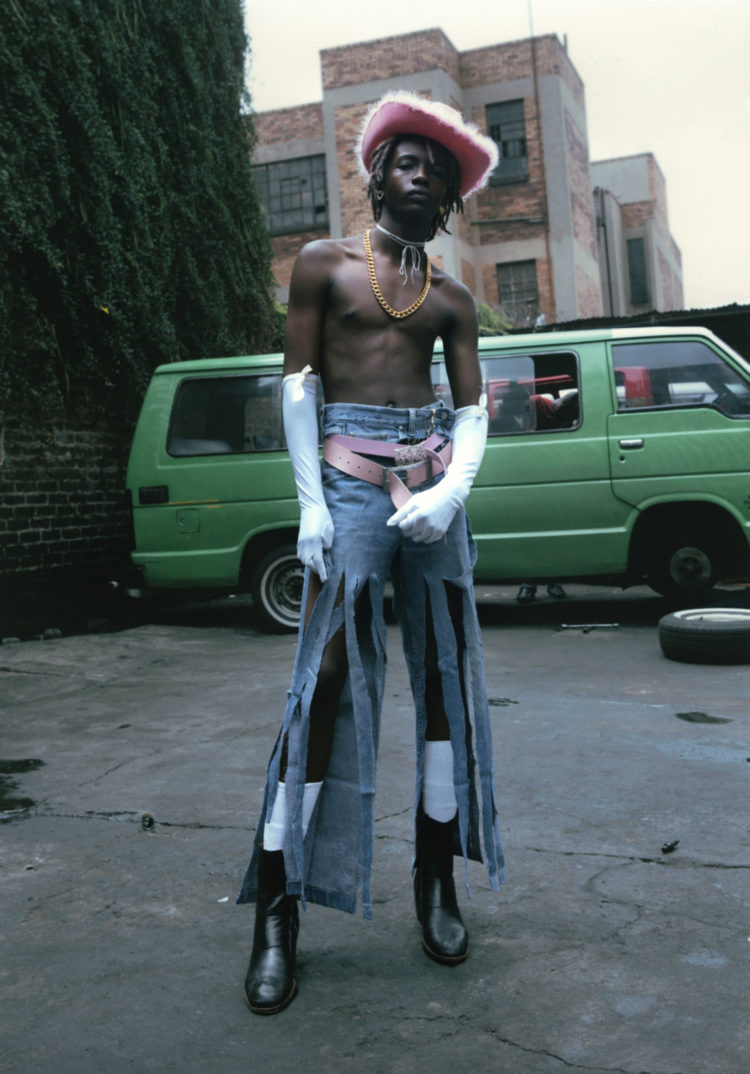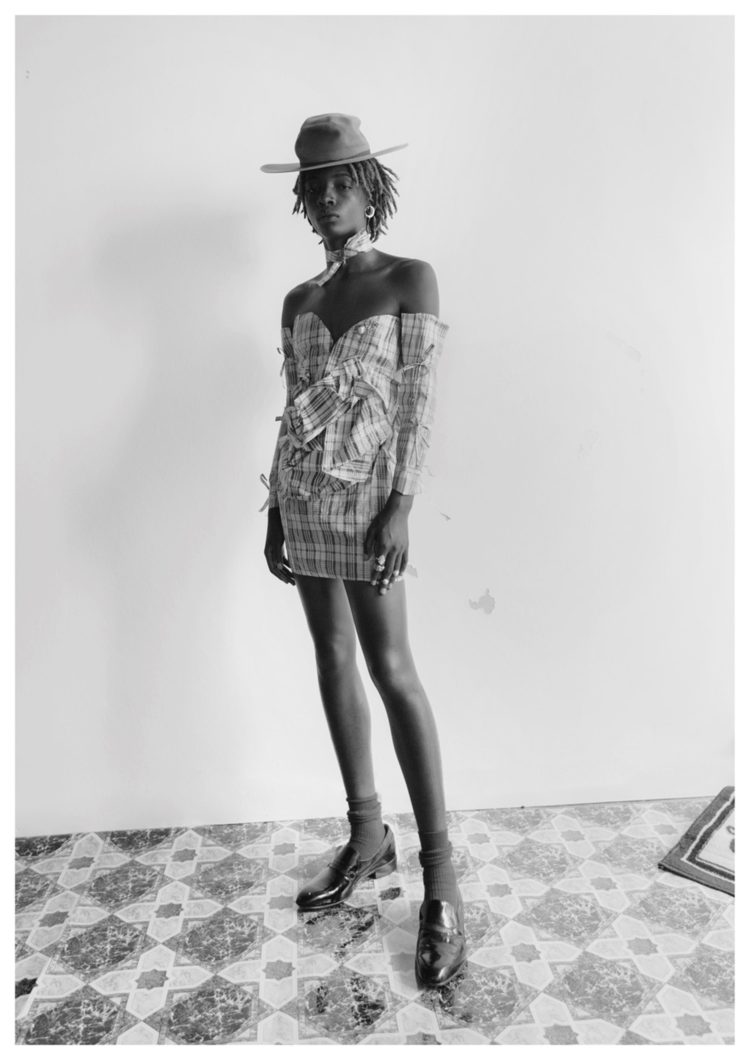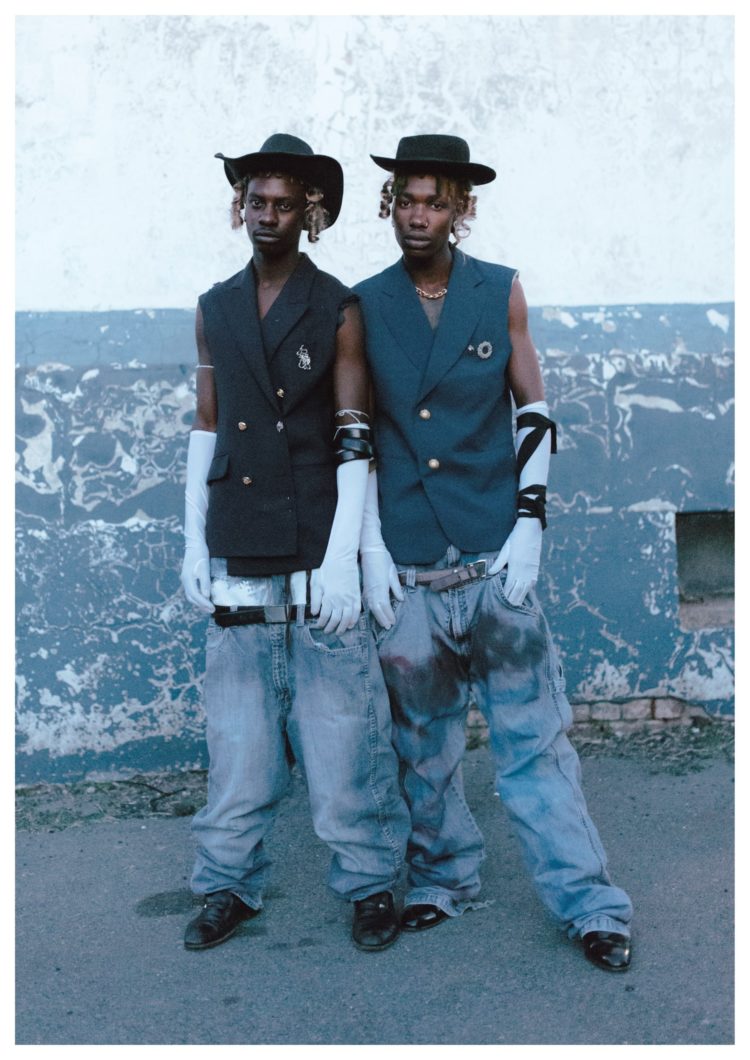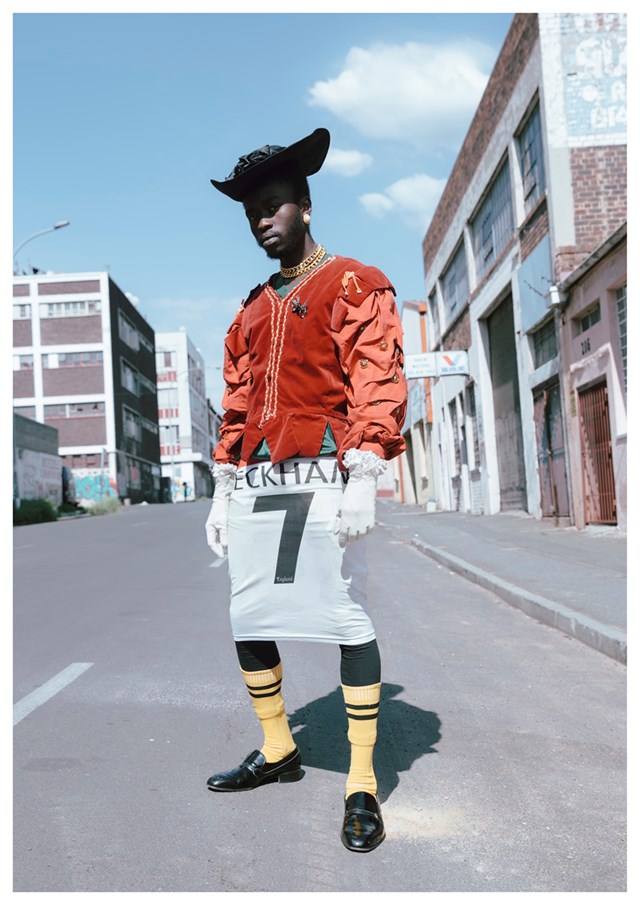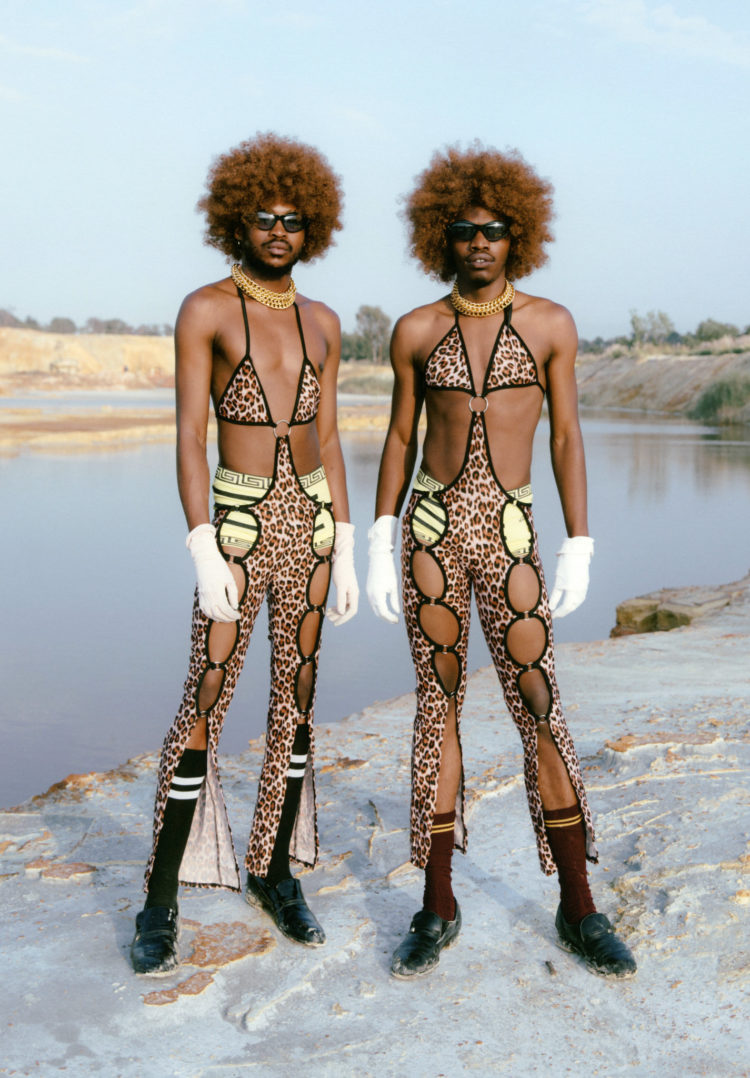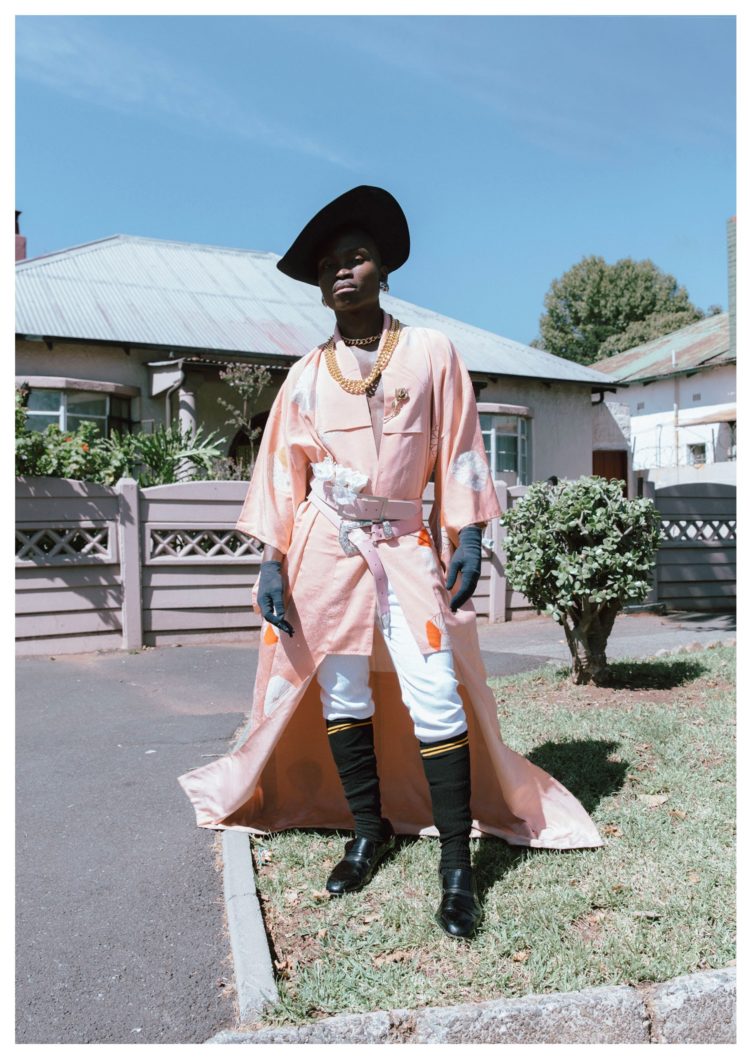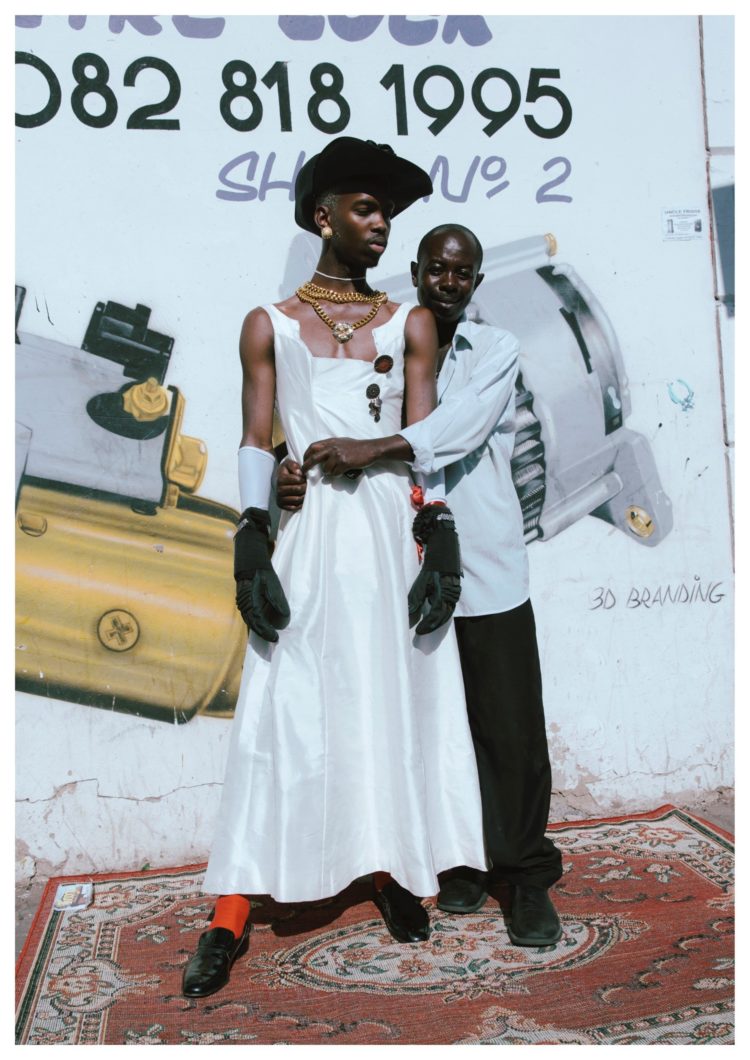2026 is a photography series by South African photographer, Kristin-Lee Moolman and London-based Sierra-Leonean stylist Ibrahim Kamara. Based in Johannesburg, Kristin-Lee connected with Ibrahim on Instagram which led to a month-and-a-half-long collaboration between the pair in Joburg.
2026 is currently on show at Somerset House, London as part of group season Utopian Voices Here and Now. I spoke to both impressive creatives about the concepts behind 2026 and the stories behind the images.
What type of work are you showing in Utopian Voices Here and Now?
Ibrahim: We’re showing Africa in ten years’ time. We created this world on black bodies where there’s no right or wrong.
A man wearing a dress doesn’t mean he’s sexually confused.
We wanted to experiment on the man’s body and play with sexuality, identity and the notion of the ‘New Africa’ while not placing any labels, even though I mention sexuality. A man wearing a dress doesn’t mean he’s sexually confused, he’s just comfortable in a dress: that’s the kind of vibe we were going for. Anything goes.
What was the driver behind starting this series?
Kristin-Lee: The driving force behind the project is to challenge and deconstruct negative stereotypes perpetuated by western media, as well as South-African media, to contest the stigma of being defined as a collection of third-world countries – stereotyped as violent, impoverished, uneducated and underdeveloped.
2026 explores how black masculinity is defined and policed.
More specifically, 2026 explores how black masculinity is defined and policed in popular culture and global media. To contest how black skin is utilised as an exotic object – where the wearer becomes only a faceless and nameless commodity.
How has the response in Joburg been to the project?
Ibrahim: I think it was great, I felt like SA was the most progressive place in Africa and that’s why I wanted to go there. They have gay rights and gay people are free to do whatever they want.
Africa needs that open-mindedness.
It’s just a little more progressive and open-minded. Africa needs that open-mindedness. Just because you and I are different doesn’t mean we have to be enemies. We can still live together, side by side and just live our lives.
Kristin-Lee, what was the working relationship like between Ibrahim and you during shooting? Were a lot of the shoots planned way in advance? Or was the process a lot more spontaneous?
Kristin-Lee: We discussed the concepts and process at length in the months leading up to the project, but when it came to the reality of shooting there was so much more to show and digest – from the outset there was a subconscious symbiosis between Ib (Ibrahim) and myself – I think resulting from a mutual desire to challenge and change perceptions. This led to us exploring the themes outlined and more.
I felt, personally, it was a great privilege to work with someone whose work I respect and have admired for some time, and to find that a shared vision existed between us was pretty much the icing on the cake.
How do you feel the fashion scene in Joburg fares with London?
Ibrahim: I think in London we follow trends – ‘what’s hot’ – and we all dress a certain way. One of the things I find when I travel is that people don’t know much about trends so they create their own style. You’ll find someone with a big hat and this amazing print, and they’re shirtless. And that’s the look for the day. You’d never find that in the streets of London. Everyone is just copying everyone, everyone wants to fit in.
In the developing world people see clothing differently to the way people see clothing here. They just put everything together, there’s a level of excess and not filtering anything that I really love. After a period of time it becomes a style, it becomes a cultural reference, because they’re just being themselves.
I’ve never seen black boys express themselves so freely. Especially in Africa.
That’s what I love about South Africa: I’ve never seen black boys express themselves so freely. Especially in Africa. They wear whatever they want to wear, they dye their hair whatever colour they want to and wear earrings. The gay community is so vibrant, these girls, we call them the ‘dolls’ they wear whatever they want to wear. People like FAKA are leading voices in African imagery. They’re really pushing the boundaries.
What’s unique about shooting in SA?
Kristin-Lee: Johannesburg is a South-African city on the verge of awakening – for the first time we are looking inwards, realising we as individuals have our own unique power and the potential to affect real change within our society. The creative process throughout 2026 was largely influenced by the this social climate as well as the respective backgrounds of Ibrahim and myself.
I would say the most powerful realisation came from the boys we worked with, they refuse to let their masculinity be dictated to them, and where gender is a label to be applied loosely – there is a general acceptance of people of various races and sexual orientation.
How much has growing up in Sierra Leone affected your styling?
Ibrahim: I’ve really taken a lot from my experiences growing up and during the war. I left the war and fled to The Gambia and lived there. A lot of kids who grew up in a war, grow up in a very political state of living. Instead of the TV, I’d be listening to the radio. If the rebels are coming, how far are they? Watching CNN, I’d be checking what’s happening.
Those ideas really affect the way I think now. I don’t want to just create a beautiful image, I want it to say something. I want it to communicate something to the viewer because there’s always a meaning behind the image. I think my background in Africa really affects my creativity, to reduce ideas and clash things together. If I didn’t have the background I do, I wouldn’t be producing what I’m producing now.
Where did you source the clothes and what were the shoots like?
Ibrahim: I got some stuff from charity stores in London but I couldn’t take all that stuff to Joburg, it was too expensive. I was so silly because you can find everything in Africa.
So we were going to these thrift stores, finding these amazing suits, these amazing pieces then we went to this dumping ground where we found leather coats and other things I could work with.
I’d stay up 3 to 4:30am at night working, sketching out looks.
Some looks just developed on the scene. Kristin and I would see things and go, that would look great so we’d start chopping and cutting and pinning. Painting and strapping things around the body, I’d stay up 3 to 4:30am at night working, sketching out looks and then I’d go back to my flat and start making things.
Most of the boys we shot, mostly straight, were a bit hesitant at first to wear the pieces, but by the second look they wanted more!
We got to see people’s reactions on the streets of Johannesburg whilst shooting too. It was either very friendly or not so friendly. The not-so-friendly encounters were very rare. A lot of people were just starting, wondering what we were doing.
We had people jumping into our frames with the boys we cast. There’s one image of the guy in a wedding dress and this older guy just jumped into the frame and hugged him.
I didn’t want to take anything away from South African culture.
It was an amazing experience that we were all going through together. I didn’t want to take anything away from South African culture. I wanted to bring my background of Sierra Leone and London and mix it with Kristin’s background and this country and space: we all have something in common.
The things we see on the streets of London, we see on the streets of Joburg, the music, the fashion. When you clash those two together you produce something that’s never been done before. That’s what we wanted to do, and not feel like we’re taking away from anybody but just bringing cultures together.
What do you hope you will be doing in the next few year?
Ibrahim: Release an EP! I’d love to style a movie, and later on in life I want to end my career as a humanitarian.
Have any advice for emerging young photographers trying to make it?
Kristin-Lee: Ok, I have to be cheesy here, I really believe that if you really want create a legacy and powerful work – you need to be constantly connected to your creative process. Eat, sleep and breathe it.
The Instagram generation I feel has been detrimental.
Also, it takes time to create powerful work. The Instagram generation I feel has been detrimental to the creation of considered imagery with the need to post all the time, needing likes and followers to validate oneself.
It took three years of searching and experimenting to arrive at the point where I am now… after almost quitting the industry last year, somehow something clicked and I found what resonated with me. The worst thing a young photographer can do, especially as an aspiring artist is to expect instantaneous results.
Check out more about Utopian Voices Here and Now

